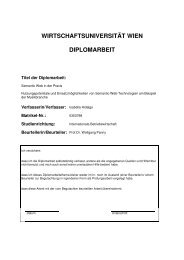Wirtschaftsuniversität Wien Magisterarbeit - SemanticLab
Wirtschaftsuniversität Wien Magisterarbeit - SemanticLab
Wirtschaftsuniversität Wien Magisterarbeit - SemanticLab
You also want an ePaper? Increase the reach of your titles
YUMPU automatically turns print PDFs into web optimized ePapers that Google loves.
• Multiple languages: Although P3P is automatically processed XML, there are<br />
some human-readable elements which can be provided in different languages. In<br />
this case, the HTTP Content-Language header can be used to indicate the language<br />
of the policy. It is also defined that if a browser requests a certain Accept-Language,<br />
the server should provide the corresponding localized policy if available and that<br />
all localized versions of a policy must have the same meaning in each language.<br />
In addition to that, within P3P XML-files the xml:lang attribute may be used to<br />
indicate the language of the human-readable elements.<br />
• The ”Safe Zone”: The P3P specification defines a “safe zone” which aims at<br />
fetching P3P policies (especially via the well-known location method) but with<br />
transferring only minimal, non-identifiable data. That means that user-agents<br />
should not send HTTP referrer headers to the safe zone and should not accept<br />
cookies from safe zone requests. In addition to that, a list of requirements for<br />
servers regarding the safe zone is also defined.<br />
• Policy and Policy Reference File Processing by User Agents: Besides<br />
accepting only well-formed XML files, user-agents should only render P3P policies<br />
and policy reference files that conform to the P3P XML schema and they should<br />
not rely on parts of P3P policies or policy reference files that do not conform with<br />
this schema. In addition to that, user-agents must not modify the XML-files in<br />
any way to make them conform with the XML schema.<br />
• Security of Policy Transport: P3P policies and policy references files should<br />
not contain sensitive information. Hence, these files do not have to be provided<br />
via HTTPS if the normal session is also non-encrypted.<br />
• Policy Updates: If a website changes its P3P policy, it must apply the old policies<br />
to the data which was collected while the old policies were in place. Websites are<br />
in charge of keeping records of old P3P policies and policy reference files (including<br />
the date when they were valid) and to make sure that these policies are applied to<br />
previously collected data. If websites want to apply a new P3P policy to previously<br />
collected data, users must accept this beforehand.<br />
• Absence of Policy Reference File: If there is no P3P policy available for<br />
a website, user-agents must assume that there is an empty policy reference file<br />
available which is valid for 24 hours. Therefore, they must check for a new version<br />
at least every 24 hours. However, website operators may publish a policy reference<br />
file that indicates that there is no policy available with an expire-date of more<br />
than 24 hours.<br />
• Asynchronous Evaluation: User-agents do not have to fetch and evaluate P3P<br />
policies before any other HTTP transactions can take place. However, until the<br />
policy has been evaluated, user-agents should treat the website as if no policy is<br />
available.<br />
21





